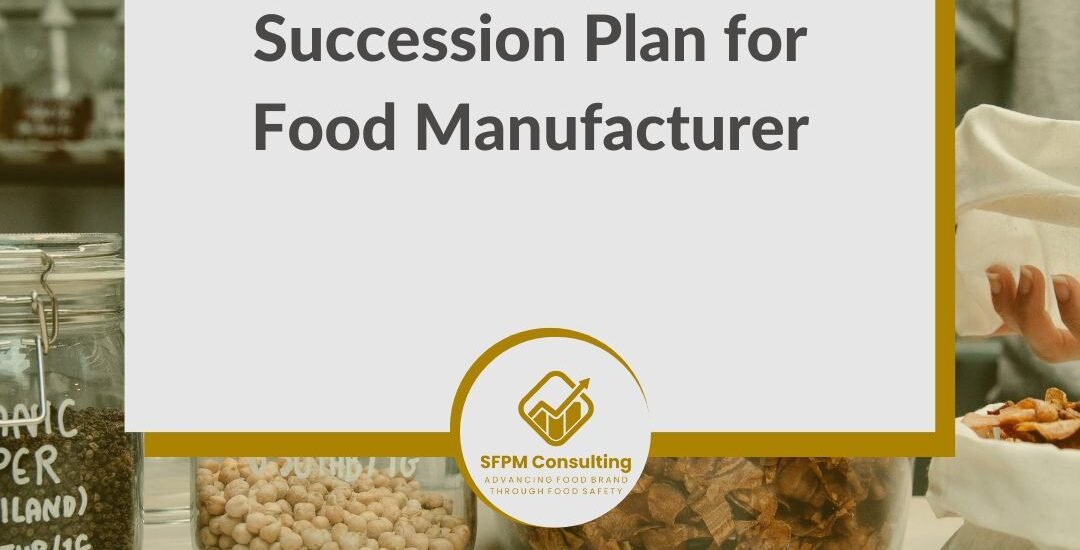Succession Plan for Food Manufacturer
- October 6, 2023
- Posted by: Felicia L
- Category: Food Leadership Series

Listen to the audiobook:
Food manufacturers face several challenges as they grow and expand. Succession planning is one critical way to ensure that business operations continue smoothly and effectively when you need to step away or pass on the reins.
This blog will provide steps for creating a successful succession plan for your food manufacturer, focusing on what you must prepare as part of the process. Additionally, we’ll explore using a checklist to ensure all tasks are completed adequately.
Steps to creating a successful succession plan for food manufacturer
You must take a few important steps to create a successful succession plan for your food manufacturer. First, you must define the roles and responsibilities of key employees. You will also want to develop a detailed job description and goal list for each position and create clear action plans to help ensure success. Finally, evaluate progress regularly and adjust your plan as necessary to maintain your business.
Why succession planning is so important for food manufacturers
In business, as in life, it’s important to have a plan. And food manufacturers are no exception. A succession plan is essential for any company that produces or distributes food products. There are many reasons why having a succession plan is beneficial:
1) It prepares the company for unexpected events and strengthens its stability. Food manufacturer businesses can be unpredictable; even the most stable companies can experience sudden downturns in sales or production due to external factors like extreme weather conditions or product recalls. Having a well-developed succession plan can help mitigate future risks by guiding who should take over roles and responsibilities when an executive leaves, retires or dies
2) Succession planning helps identify potential talent gaps and ensures that the right people are prepared to assume key organizational positions. Without a clear roadmap of who will lead which areas of operations, it may not be easy to find qualified candidates when someone unexpectedly leaves their job (or decides not to pursue advancement). A succession plan also allows you to groom new leaders before they become indispensable members of your team
3) Making sure all employees know about your plans provides clarity about expectations and eliminates any confusion or ambiguity surrounding workplace decisions. When everyone understands where they stand within the organization—and what their role entails—it fosters trust and encourages teamwork.
4) Implementing a successful succession plan enables managers to tap into previous experiences while grooming successors with fresh perspectives. By transferring knowledge down through generations instead of burning out experienced executives
What you need to prepare as part of your succession plan
Food manufacturers are constantly facing changes and a need for new ideas. This means it is important to have a plan for when someone leaves the company or retires.
To ensure continuity of operations, as food manufacturers, you can create a succession plan with clear roles and responsibilities for each position and timelines for when those positions will be filled. Additionally, you can keep an inventory of qualified candidates in case something happens unexpectedly, and they cannot find a suitable replacement immediately.
Here is a checklist of items you may want to include in your succession plan:
Designated leader(s) who will take on leadership during times of transition
- Documentation outlining roles and duties specific to each position
- Timelines detailing when those positions will be filled
- Listing of all current employees, along with their qualifications
- A list of potential successors at both junior and senior levels
- Key list of step-by-step procedures on how to perform day-to-day role
How do you use a checklist to manage your succession program?
A succession planning checklist can be very helpful in ensuring that your food manufacturer takes all the necessary steps to ensure production and customer service continuity by making sure that your food manufacturer takes all the steps needed to ensure continuity. The following are some of the steps that should be taken while using the checklist:
1) Define roles and responsibilities for each position in your organization
2) Assign individual tasks to specific employees
3) Track employee performance metrics regularly
4) Evaluate job candidates against predetermined criteria
Working With SFPM Consulting to Build Your Succession Plan for the Quality Assurance Department
Food manufacturers working with us to build and implement their food safety management system automatically get an upgrade regarding succession plans. At SFPM Consulting, we make systems. Our program development and implementation allow us to retrain your staff on what to expect if your key personnel leaves; ensuring your hard-built food safety management systems are continuously implemented is important with short notice.
Further on, if you are aware of your staff getting to the retirement age, it is also important to plan for their retirement early. We can work with you to build procedures for their daily role so the “know-how” or “company secrets are being kept”. Don’t worry. All of the developed systems are completely confidential.
With the high turnover in the food industry, ensuring your hard-built food safety management systems are continuously implemented is important. It also helps your new hires manage the program effectively and not have to stress about how to go about your food safety program.
We care for our clients, and it is important to us to offer a succession plan to support our client’s food safety success.
Thinking about your succession program or managing your next audit/inspection, book a meeting to see if we can help: https://tidycal.com/sfpmconsulting/strategy-call
Succession Plan Key Takeaway
It is important to build a succession plan, even if you are not leaving the company. It allows your team members to be cross-functionally trained and know what to expect. Plus, it helps to build leadership.
Can we help you with your QA succession plan? Let’s connect. 🙂
